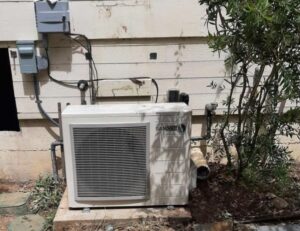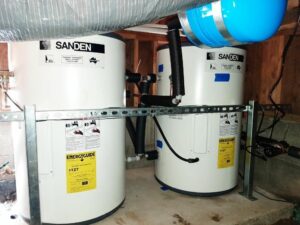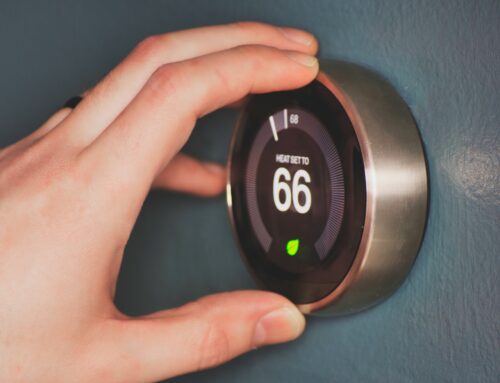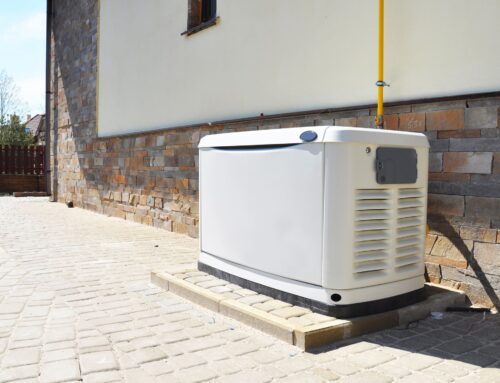Domestic hot water heat pumps do have some good options and they come in two different types.
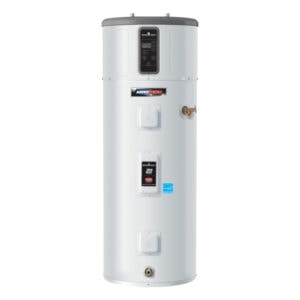 The first and most common is a self-contained heat pump water heater. This is just a tank with a heat pump mounted on the top of the tank. This is usually an electric element in the tank to act as auxiliary or back up heat. Unfortunately, I see a lot of installation mistakes with these.
The first and most common is a self-contained heat pump water heater. This is just a tank with a heat pump mounted on the top of the tank. This is usually an electric element in the tank to act as auxiliary or back up heat. Unfortunately, I see a lot of installation mistakes with these.
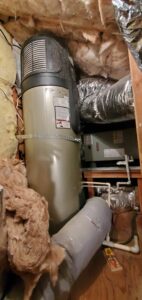 The most common mistake is placement. If the installing contractor does not understand how a heat pump works, they will install them in spaces like a closet or attic where they absorb the heat out of the air and stop heating efficiently. The worst I have seen is a heat pump water heater installed in a laundry room closet with louvered doors. When the heat pump water heater ran, it was noisy in the laundry room and hallway, and it made it very cold in that area. The client turned the heat pump function off and used just the electric elements.
The most common mistake is placement. If the installing contractor does not understand how a heat pump works, they will install them in spaces like a closet or attic where they absorb the heat out of the air and stop heating efficiently. The worst I have seen is a heat pump water heater installed in a laundry room closet with louvered doors. When the heat pump water heater ran, it was noisy in the laundry room and hallway, and it made it very cold in that area. The client turned the heat pump function off and used just the electric elements.
It’s a shame when you see an expensive machine that is intended to make things better incorrectly installed and often making things worse. As a consumer, you rely on contractors to make decisions that will serve you well. It is frustrating when we have to tell a client that a modern, expensive machine that they paid for is not working correctly because of a simple mistake.

Fortunately, the self-contained heat pump water heaters can be ordered with a duct collar kit. This will allow the water heater to be installed in an enclosed space but discharge and/or draw air from an adjacent space. Now, the new heat pump water heater can go into the same closet as the original water heater with minimal extra effort to make it right.
The second common mistake that I see is sizing the equipment correctly or educating the client on how heat pump water heaters work. Almost all of the self-contained heat pump water heaters have a capacity of 4500 BTU. Compare that to a simple natural gas 40-gallon water heater that has an input range of 22,000 to 30,000 BTU. That large difference translates to a much slower recovery when the hot water is depleted from the tank. The initial hot water draw from the tank will be fine, but maintaining hot water use will overwhelm the heat pump water heater quickly and it will take a long time to bring it back up to temperature. I always encourage my clients to use the larger tank when offering a heat pump water heater so that will have a lot of hot water on hand and can comfortably wait for the hot water to replenish.

The second type of heat pump water heater is a split system. This puts the heat extraction components outside. SanCo2 is currently the only company with a good product for this application. It is very reliable and effective. This type of system means the water storage tank is now just a storage tank. It will not make noise or have any effect on the air around it. The hall closet is a great place for this tank, and you can cover the vent holes that the original gas fired water heater needed. Small piping between the tank and the outdoor heat pump provides the heat transfer. The outdoor component looks just like a Mitsubishi outdoor unit. (Sanco2 picture (manufacturer))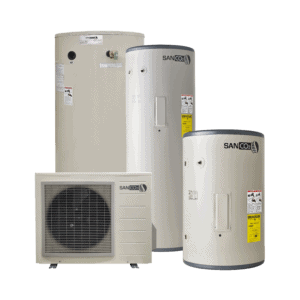
The outdoor unit for a SanCo2 system will transfer heat at a rate of 15,000 BTU. This is lower than the gas fired tank water heater, but still a lot higher than the 4500 BTU tank heat pump water heater. We do still encourage our customers use the larger tank, even with the SanCo2 systems to make sure their hot water capacity is exactly what they need.
